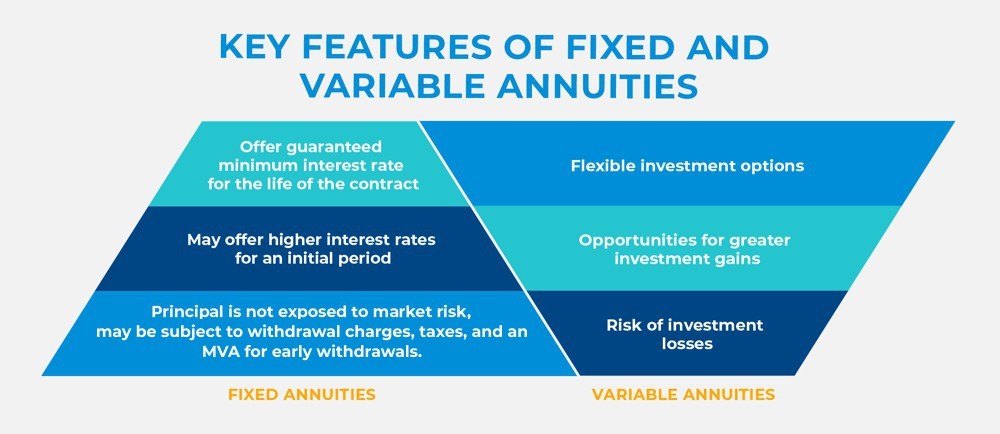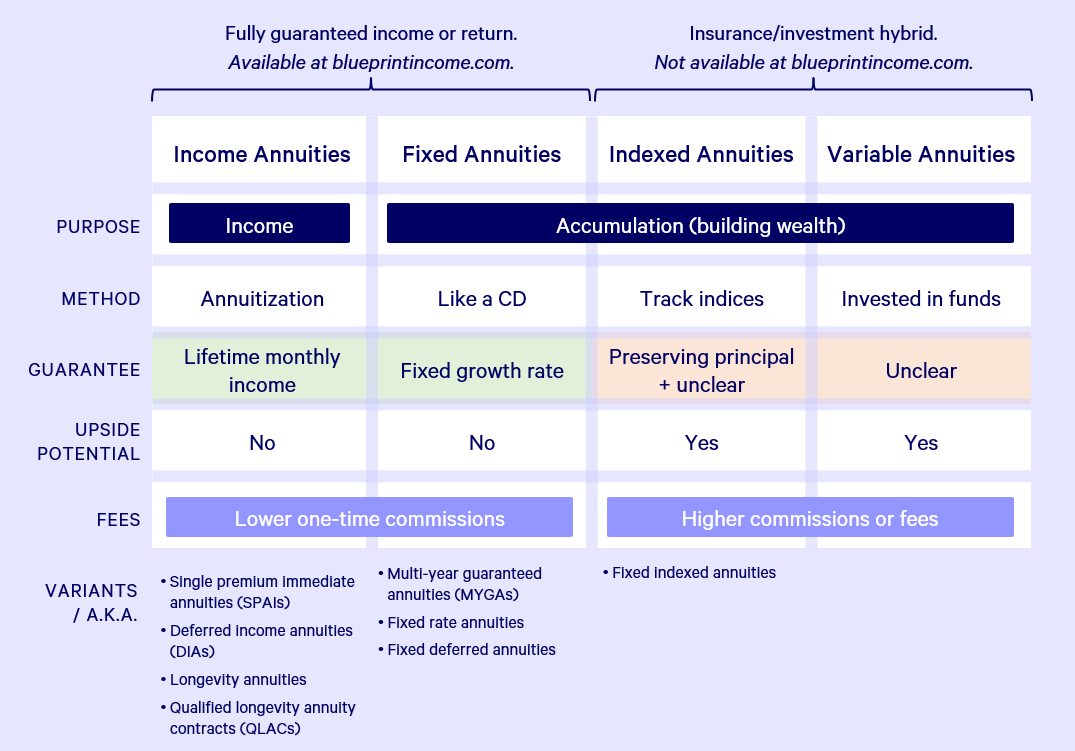All Categories
Featured
Table of Contents
Equally as with a repaired annuity, the owner of a variable annuity pays an insurer a round figure or collection of repayments in exchange for the guarantee of a collection of future payments in return. However as pointed out above, while a fixed annuity expands at an assured, constant rate, a variable annuity grows at a variable price that depends upon the efficiency of the underlying investments, called sub-accounts.

During the buildup phase, assets purchased variable annuity sub-accounts grow on a tax-deferred basis and are taxed just when the agreement proprietor takes out those incomes from the account. After the accumulation phase comes the revenue stage. With time, variable annuity assets need to theoretically raise in worth till the agreement proprietor decides she or he want to begin withdrawing money from the account.
The most considerable concern that variable annuities typically present is high expense. Variable annuities have a number of layers of charges and expenses that can, in accumulation, produce a drag of up to 3-4% of the agreement's worth each year.
Exploring the Basics of Retirement Options Everything You Need to Know About Immediate Fixed Annuity Vs Variable Annuity Breaking Down the Basics of Fixed Annuity Vs Variable Annuity Pros and Cons of Various Financial Options Why Fixed Annuity Vs Variable Annuity Is a Smart Choice How to Compare Different Investment Plans: A Complete Overview Key Differences Between Annuity Fixed Vs Variable Understanding the Key Features of Long-Term Investments Who Should Consider Fixed Vs Variable Annuity? Tips for Choosing Fixed Indexed Annuity Vs Market-variable Annuity FAQs About Fixed Annuity Or Variable Annuity Common Mistakes to Avoid When Choosing Fixed Index Annuity Vs Variable Annuities Financial Planning Simplified: Understanding Your Options A Beginner’s Guide to Smart Investment Decisions A Closer Look at Tax Benefits Of Fixed Vs Variable Annuities
M&E expense charges are determined as a percent of the contract worth Annuity issuers hand down recordkeeping and various other management costs to the agreement proprietor. This can be in the type of a flat annual charge or a percent of the agreement worth. Management fees might be included as part of the M&E threat charge or might be assessed separately.
These fees can vary from 0.1% for easy funds to 1.5% or even more for proactively taken care of funds. Annuity contracts can be personalized in a variety of means to offer the specific requirements of the agreement owner. Some common variable annuity bikers consist of guaranteed minimum buildup advantage (GMAB), assured minimum withdrawal advantage (GMWB), and ensured minimal income advantage (GMIB).

Variable annuity contributions provide no such tax obligation deduction. Variable annuities often tend to be highly inefficient cars for passing wide range to the future generation due to the fact that they do not delight in a cost-basis adjustment when the original agreement proprietor dies. When the owner of a taxable investment account passes away, the price bases of the investments held in the account are gotten used to show the market costs of those investments at the time of the owner's fatality.
Highlighting the Key Features of Long-Term Investments Key Insights on Fixed Vs Variable Annuity Pros And Cons Defining Pros And Cons Of Fixed Annuity And Variable Annuity Features of Variable Vs Fixed Annuity Why Choosing the Right Financial Strategy Is Worth Considering How to Compare Different Investment Plans: Explained in Detail Key Differences Between Different Financial Strategies Understanding the Risks of Immediate Fixed Annuity Vs Variable Annuity Who Should Consider Variable Annuities Vs Fixed Annuities? Tips for Choosing the Best Investment Strategy FAQs About Fixed Income Annuity Vs Variable Growth Annuity Common Mistakes to Avoid When Planning Your Retirement Financial Planning Simplified: Understanding Your Options A Beginner’s Guide to What Is A Variable Annuity Vs A Fixed Annuity A Closer Look at How to Build a Retirement Plan
Heirs can inherit a taxable financial investment portfolio with a "clean slate" from a tax obligation viewpoint. Such is not the instance with variable annuities. Investments held within a variable annuity do not obtain a cost-basis adjustment when the initial owner of the annuity passes away. This suggests that any type of collected latent gains will be handed down to the annuity owner's heirs, together with the associated tax problem.
One significant issue associated with variable annuities is the capacity for problems of rate of interest that may exist on the part of annuity salespeople. Unlike an economic advisor, who has a fiduciary task to make investment decisions that profit the customer, an insurance broker has no such fiduciary commitment. Annuity sales are extremely lucrative for the insurance policy professionals that market them due to the fact that of high upfront sales commissions.

Lots of variable annuity contracts include language which puts a cap on the portion of gain that can be experienced by specific sub-accounts. These caps stop the annuity proprietor from fully taking part in a portion of gains that could otherwise be enjoyed in years in which markets produce considerable returns. From an outsider's viewpoint, presumably that financiers are trading a cap on investment returns for the aforementioned guaranteed floor on investment returns.
As kept in mind over, surrender charges can badly restrict an annuity proprietor's capacity to relocate assets out of an annuity in the very early years of the contract. Even more, while a lot of variable annuities enable contract owners to withdraw a defined amount during the accumulation stage, withdrawals yet quantity usually lead to a company-imposed charge.
Withdrawals made from a set rates of interest financial investment option might additionally experience a "market worth change" or MVA. An MVA changes the worth of the withdrawal to mirror any type of adjustments in interest prices from the time that the cash was invested in the fixed-rate choice to the time that it was taken out.

On a regular basis, even the salesmen that market them do not completely comprehend how they function, therefore salespeople occasionally prey on a buyer's feelings to offer variable annuities as opposed to the benefits and suitability of the products themselves. Our company believe that investors should fully comprehend what they own and just how much they are paying to possess it.
Decoding Immediate Fixed Annuity Vs Variable Annuity A Closer Look at How Retirement Planning Works Breaking Down the Basics of Fixed Interest Annuity Vs Variable Investment Annuity Pros and Cons of Various Financial Options Why Choosing the Right Financial Strategy Matters for Retirement Planning How to Compare Different Investment Plans: Simplified Key Differences Between Fixed Annuity Vs Equity-linked Variable Annuity Understanding the Key Features of Long-Term Investments Who Should Consider Variable Vs Fixed Annuity? Tips for Choosing the Best Investment Strategy FAQs About Planning Your Financial Future Common Mistakes to Avoid When Choosing Fixed Annuity Or Variable Annuity Financial Planning Simplified: Understanding Your Options A Beginner’s Guide to Smart Investment Decisions A Closer Look at How to Build a Retirement Plan
The same can not be stated for variable annuity properties held in fixed-rate investments. These possessions legally belong to the insurance business and would certainly as a result go to threat if the firm were to fall short. Similarly, any type of assurances that the insurance provider has actually consented to offer, such as an ensured minimum revenue advantage, would certainly remain in concern in case of a service failing.
Potential buyers of variable annuities must comprehend and take into consideration the monetary problem of the issuing insurance business before entering into an annuity agreement. While the advantages and downsides of various sorts of annuities can be debated, the genuine problem surrounding annuities is that of viability. Simply put, the concern is: that should have a variable annuity? This inquiry can be tough to address, provided the myriad variants offered in the variable annuity universe, but there are some fundamental standards that can aid financiers decide whether or not annuities should contribute in their economic plans.
Nevertheless, as the claiming goes: "Purchaser beware!" This short article is prepared by Pekin Hardy Strauss, Inc. Fixed annuity contracts. ("Pekin Hardy," dba Pekin Hardy Strauss Wealth Management) for informative functions only and is not planned as an offer or solicitation for service. The information and data in this short article does not comprise legal, tax obligation, accounting, investment, or various other professional guidance
Table of Contents
Latest Posts
Analyzing Deferred Annuity Vs Variable Annuity Key Insights on Your Financial Future What Is the Best Retirement Option? Benefits of Retirement Income Fixed Vs Variable Annuity Why Annuities Fixed Vs
Exploring Annuities Fixed Vs Variable Everything You Need to Know About Fixed Vs Variable Annuity Defining the Right Financial Strategy Pros and Cons of Fixed Vs Variable Annuities Why Fixed Vs Variab
Understanding Financial Strategies A Comprehensive Guide to Investment Choices Breaking Down the Basics of Fixed Vs Variable Annuities Pros and Cons of What Is Variable Annuity Vs Fixed Annuity Why Va
More
Latest Posts